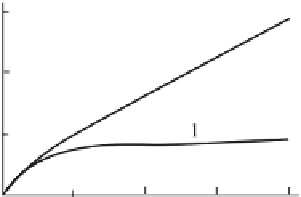Geoscience Reference
In-Depth Information
Figure 2.23 shows the dependence of the energy
W
2
of a wave, excited by
a running displacement, upon the velocity of the displacement propagation,
v
.
When the parameter
b
/
H
>
2, the dependence exhibits a maximum, determined by
the value of
b
/
H
, in the region of
v
(g
H
)
1
/
2
. The figure presents the relationship
between the fractions of energy attributed to waves running along (
W
+
) and against
(
W
−
) the direction of propagation of the running displacement versus the displace-
ment velocity. This dependence also has a maximum in the vicinity of
v
∼
1. When
the parameter
b
/
H
decreases, the maximum is shifted noticeably towards smaller
velocities. When the propagation velocity of the displacement increases, the curves
in Fig. 2.23b asymptotically tend towards unity, independently of the value of
b
/
H
,
which points to a loss of orientation by the energy emission at large values of
v
.
Figure 2.24 presents the dependence of the maximum possible energy of waves,
excited by piston-like and running displacements of the basin bottom, upon the pa-
rameter
b
/
H
. In the case of
b
/
H
<
2 the type of displacement is seen to be irrelevant.
When
b
/
H
>
2, a running displacement turns out to be capable of exciting waves
more effectively than a piston-like displacement, and, while curve 1 tends asymp-
totically towards an evident long-wave limit equal to unity, the maximum energy of
a wave, excited by a running displacement actually increases linearly with the pa-
rameter
b
/
H
. It must be noted that in this case the linear increase of dimensionless
energy signifies a quadratic dependence of its dimensional value upon the size of
the generation area,
b
.
∼
a
b
Fig. 2.23 Energy of waves (a), excited by a running displacement versus the propagation veloc-
ity of the displacement. b—The relationship between the fractions of energy attributed to waves
running along (
W
+
) and against (
W
−
) the direction of propagation of the running displacement
versus the displacement velocity for
L
= 10, 5, 2 and 1 (1-4, respectively)
Fig. 2.24 Dependence of
maximum possible energy of
waves, excited by piston-like
(1) and running (2) displace-
ments, versus the size of
the generation area












































